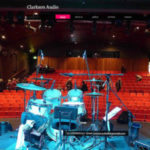Forums › Forums › CQ Forums › CQ troubleshooting › CQ20B: First Live Use – Problems…
Tagged: CQ20B
- This topic has 24 replies, 5 voices, and was last updated 1 month, 2 weeks ago by
Ensoniq Nut.
-
AuthorPosts
-
2024/01/28 at 9:08 pm #118895
Bonecat
ParticipantThis one will be a bit long – buckle up…
Use Case: 5 Piece Cover Band – Drums, bass, 2 guitars, Vocalist
Gear: CQ20B, Shure GLXD-4 wireless mics (2.4G), Sennheiser EW-G4 wireless IEM systems (500-600MHz), mics and IEMs use antenna combiners to remote paddle antennae, bass and guitars go direct via pedalboards/modelers using 5.8 wireless systems, dBX PA2 driverack feeds QSC subs/tops, stage WiFi via Ubiquiti Dream Router running 5GHz only on hidden network with WEP/WPA2.
We’ve been using the CQ in rehearsal for a about 6 weeks and decided to take it out on its first live show last Friday. I run sound from the stage using CQ MixPad, everyone else runs their own IEM mix via the CQ4You app. Soundcheck seemed to go well and I liked the initial main mix in FOH. Bandmates are still sorting out CQ4You but everyone seemed ready to go. So far, so good…
Start first set and I almost immediately start seeing confused looks from my bandmates. Between songs they tell me that their IEM mixes are changing while we’re playing, that they cant hear their instruments when the voices get going or vice versa. The details of each person’s complaints vary slightly, but the overall theme is that the mix they set at soundcheck changed. Our lead singer said that she lost her own voice in her IEM mix altogether. I checked everything I could see and didn’t find any obvious error, which was perplexing. Gain Assistant was used to set initial gain levels, auto gain was set to off. Possibly important to note that as I was mixing from the stage, I was using CQ MixPad and not CQ4You. My IEM mix was fine all night. Needless to say, the IEM mix issues were distracting and we probably didn’t do our best as a result.
Everything except the CQ and associated apps are things we’ve used for years and they’re all operating normally. The venue was one we’ve played at dozens of times without issue.
The only thing I’m left with is that this has something to do with CQ4You – user error, a bug somewhere, dunno. What they describe reminds me me very strongly of automix behavior, but it wasn’t on. My band mates don’t find the group functions in 4You to be helpful, so they put everything in one group and use the fader screen to run their mixes.
I’m setting everything up in our practice studio as it was at the show and will try to recreate the problem, but I’m really hoping that someone here can help me get this fixed. I really want the CQ to be our primary live tool, but if my bandmates can’t get a stable, reliable IEM mix, it’s going to become problematic very quickly.
Thanks,
Phil “Bonecat” Schrantz
2024/01/28 at 9:47 pm #118898Mike C
ParticipantAre your monitor mix / aux sends set to PRE or POST fade?
The monitor mixes should be set PRE fade. If they are set to POST fade
changes made to the main mix will also change the levels on the monitor mixes.Do the band members have their actual mix set up on their device they are using
with CQ4 You? If not they are controlling some other persons mix.2024/01/29 at 12:11 am #118901JayDee
ParticipantThis may be a longshot, but make sure that the AMM is disabled. I think that it’s accessed from the configuration screen.
2024/01/29 at 1:49 am #118905 GParticipant
GParticipantI’m not assuming this is the solution but I believe it is worth noting.
If your bands material is frequency heavy specifically at 19khz this can cause some pretty serious IEM issues. Major loss of volume or drop outs. 19khz is the pilot tone for iem transmitters and receivers. if there is too much 19khz the transmitter meters will appear to peak and ruin the mix until that frequency tames down. this is simply avoided by narrowly notching out 19khz on all outputs that feed your iem transmitters.2024/01/29 at 2:41 am #118906Bonecat
ParticipantGot in the studio and hooked everything up in there as it was at the show. Verified that gains were correct, pick points were correct, and automatic mixing is/was off. Verified that CQ4You worked on my own IEM aux. Will test the others tomorrow, but can’t really do much more until the band gets together for rehearsal, hopefully Thursday. Very perplexed and concerned about this as it has mission-critical implications for us. If everyone can’t build and maintain a stable IEM mix, it won’t work for us…. Hmmmmmm…
I’ll report further as things develop…
2024/01/29 at 4:24 pm #118919Brian
ParticipantAre the band members using good quality isolating IEMs? If they are not sealing/isolating well, it could easily be the extra noise in the venue during the show caused issues with what they were hearing in the IEM. What might have worked in a “quiet” rehearsal space/sound check could be totally different in a loud venue with a loud crowd.
2024/01/29 at 7:38 pm #118924Bonecat
ParticipantThank you for everyone’s input.
We are all using quality IEM earbuds – Shure, Westone, 64 Audio. 3 of us are wearing custom molds, the other two are using comply foam tips and say they have consistent isolation. Our drummer is, um, enthusiastic, and a poor seal is readily apparent.
We’ve used this wireless gear at this venue dozens of times, always deployed the same way with no issue, but I’ve set a 19KHz notch in the IEM feeds, just in case. I plan on reviewing their individual CQ4You settings at rehearsal…
2024/02/04 at 12:20 am #119108Bonecat
ParticipantUpdate: Went through all cables and verified no issues. Latest firmware is on board. Set up system in our studio as it was at the gig. Reviewed bandmates CQ4You settings and they’re fine. During rehearsal two people indicated that their IEM mix was changing without any input from them. No one else was accessing their mix.
Keith or anyone else with A&H: Now what?
2024/02/04 at 12:32 am #119109Mike C
ParticipantDo you have a lot of limiting maybe kicking in too soon on the IEM mixes?
What is changing, individual channel levels in the monitor mixes or the full monitor mix level.
Try PLF’ing the monitor mix on the mixer and listen to it with headphones plugged into the mixer.
2024/02/04 at 1:35 pm #119117Monkee
Participantsame issue with the cq18t , just basic set up, piano & vocal levels seemed consistent throughout practise , added bass guitar & the vocal level & piano seems to lose volume & wondered if the gain assistant was kicking in ? set to off & still needed to lift volume on the vocal & piano faders to get back to clarity? Any ideas?
2024/02/05 at 6:15 pm #119160Bonecat
ParticipantIndividual channel levels within a mix seem to be changing in response to high energy in other individual channels in that mix. It sounds as if there’s some kind of digital limiting or leveling happening, where the high energy signal is attenuated, bringing the other components of the mix down with it. Players perceive that as those other components disappearing from their mix.
AutoGain and AMM are both off. I use gentle compression on vocals, guitars, and kick. Bass is compressed pre-mixer. No limiting is applied at the IEMs. I’m stumped, but this behavior is unacceptable…
I’ve reached out to the A&H US distributor about this with no resolution yet.
2024/02/05 at 6:33 pm #119162 Lee7Participant
Lee7ParticipantHave you tried switching off all compression/limiters for your Aux’s to see if the problem goes away?
2024/02/06 at 9:06 am #119178 KeithJ A&HModerator
KeithJ A&HModerator@Bonecat
There are quite a few places where level or dynamics could be affecting the signal from input source to IEM’s without purposeful adjustment, and it sounds like you’ve checked most of them on the mixer.
Inputs – you mention Auto Gain is off
Input channels – AMM off, sends to monitor outputs are post-PEQ (pre-comp) so no worry there.
Output channels – Comp and Limiter, as @Lee7 says, check these are off or at least doing what you want them to and no more.
Control via app – You suggest there may be a bug, but the app is only a remote control for the mixer itself. If send levels to an output have changed, you will see that on all apps (CQ4You and CQ-MixPad). There is no automatic adjustment of these levels, it does what you tell it to.
To rule out any changes, store a scene once everything is set as desired, then play until the issue is definitely present (without making any adjustments!) and store another scene. You can then set two of the SoftKeys up to recall each of the scenes, allowing you to switch between them whilst viewing the send levels for each mix.I would never say never to any possible bug, but if there were an issue with the CQ or the apps, we would likely have found it before release, or would be getting reports of this from the thousands of units in the field.
Other things which you haven’t mentioned:
Output levels to IEM transmitters and input levels of IEM transmitters – Check that you are not overloading the IEM transmitter inputs.
IEM system compander – The Sennheisers use a compander to compress and then expand the signal, meaning there is less dynamic range in the transmission. Not sure if this could affect things.
IEM system limiter – G4 manual notes “–18 dB to –6 dB in 6 dB steps, can be switched off”You did say that you’d used the wireless system before without issue though, so if you can confirm it was set up in exactly the same way and being fed the same signal level, it might rule these things out.
Thanks,
Keith.2024/02/07 at 4:53 pm #119246Bonecat
ParticipantThank you, Keith.
I will reevaluate the IEM system settings but as noted, we’ve used that exact set up with multiple digital mixer platforms without issue. The limiters in the IEM system are off. The audio quality in the IEMs is not noticeably clipped/distorted. FWIW, if the issue was occurring in the IEM systems, I’d expect it to affect the entire mix, rather than the differential changes my bandmates report. Compression is gently applied (2-3dB, ratios around 3:1, soft knee) to vocals, guitars, and drum mic channels. Bass is compressed pre-mixer. Output compression/limiting is not used.
I’ll continue to work with this and update here,
Thanks again,
Phil
2024/03/05 at 6:20 pm #120037dougE
ParticipantSame issues with my new CQ20B. We have definitely had the problem with various channels/signals being cut out of output/monitor mix while the band is singing and playing through numerous input channels. It has happened at gigs and also at practice. We use multiple (4) output channels for instrument and vocal monitoring and it has happened when using all wired wedges, and also when using 1 IEM with 3 wired wedges. We have had to ‘scramble’ at gigs just to run everyone through 1 output channel and chain the monitors (like the old days).
We are using latest firmware & app versions, no AMM, auto-gains not involved, no comp/limiters, min. reverb/effects, and our outputs (1-6) are set to post-PEQ, etc.
Perhaps Keith and gang will experiment more with the latest CQ20B and test/experience this? I recommend trying several full band setups and have practices with the unit, ensuring musicians are playing and singing at the same time through numerous input channels, and see if they get cuts coming through their respective output feeds.
-
AuthorPosts
- You must be logged in to reply to this topic.